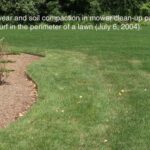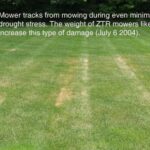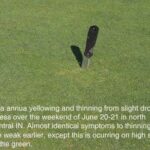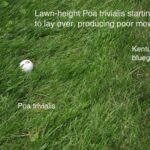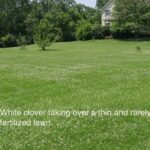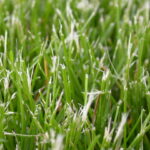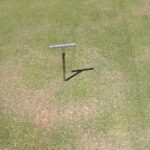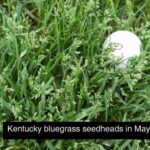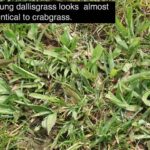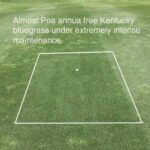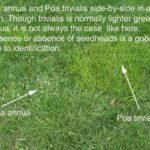Turf Tips Archives
Thinning Turf Around Lawn Perimeter from zero-turning radius mowers
The popularity of the new zero-turning radius mowers is well-justified in terms of time and energy saving devices. However, these mowers are much heavier and faster than walk-behind mowers and thus increase compaction and turf wear. This is especially important around the perimeter of lawns (commonly referred to as the clean-up passes) where the mower […]
Brown Tracks in Lawn
I’ve seen lawns and heard this week about brown streaks that are about the width of the mower (photo). In the vast majority of the cases, these tracks are caused by the weight of a mower traversing across a portion of the lawn that was drought-stressed. Drought stress may not have been easily visible before […]
Reminder of Midwest Regional Turf Field Day on July 27
The Midwest Regional Turf Field Day will be held on July 27 at the Wm H Daniel Turfgrass Research and Diagnostic Center in West Lafayette. This is a great opportunity for turf professionals to view the latest in turfgrass research, talk to Purdue specialists about turf and ornamental issues, and visit with exhibitors displaying the […]
News about Japanese beetles is mostly bad!
Japanese beetles are back! They appeared 10 days to 2 weeks earlier than normal this year and indications are pointing to a very heavy population in many parts of the state. Last years weather conditions kept soils moist which apparently led to a very successful grub hatch. Early emergence usually points to a somewhat earlier […]
Finicky Poa annua Yellowing and Thinning on Greens
In spite of the cool and dry weather, Poa annua continues to yellow and sometimes thin on golf greens. Last week Poa annua was thinning and dieing in low areas from too much water, heat, and humidity (photo). However, the cool dry weather over the weekend allowed for maximum water loss through evapotranspiration. Plus since many irrigation systems were […]
Summer stress of Poa annua and Poa trivialis in Lawns and Sports Fields
Poa annua (annual bluegrass) and Poa trivialis (rough bluegrass) in athletic fields and lawns are starting to show signs of stress. The signs of stress include laying over (poor mow-ability), yellowing, and thinning. Patches of these fine-bladed grasses seemingly die overnight with even a minimum of drought stress. Though these grasses may have blended in with the desired turf […]
White Clover in Golf Courses, Sports Turf, and Lawns
The small white flowers of white clover are very visible right now and it may appear that clover is taking over, especially under-fertilized turf areas. Clover is a legume and is very competitive under low N conditions, so increasing annual N is best method for long-term control. The temptation is to apply a herbicide now […]
Doug Richmond Joins Turf Program in Entomology Research
Dr. Doug Richmond has recently accepted the turfgrass entomology faculty position at Purdue University. Doug is the first of the projected six positions of Purdue’s initiative on sustainable urban ecosystems. Dr. Richmond joins the Turf Program after completing his M.S. and Ph.D. and Ohio State University in Columbus under Dr. David Shetlar and his Post […]
Midwest Regional Turf Field Day on July 27
The Midwest Regional Turf Field Day will be held on July 27 at the Wm H Daniel Turfgrass Research and Diagnostic Center in West Lafayette. This is a great opportunity for turf professionals to view the latest in turfgrass research, talk to Purdue specialists about turf and ornamental issues, and visit with exhibitors displaying the […]
June Checklist
With the constant rains in May and now June, many turf management practices have been delayed and many practices have to be modified as a result of the rain: Fertilization: With all extended growth period using up much of the soil N plus the potential of minor N loss through leaching from all the rain, a […]
Time to consider a change…?
We are finally getting near the end of the spring growth flush for our major cool-season lawngrass species like Kentucky bluegrass, ryegrass and tall fescue. With a little help from mother-nature, hopefully mowing will be more manageable from here on out. During the past few weeks you may have noticed a decline in overall appearance […]
Early Dollar Spot on Golf Courses This Year
If you’re lucky enough to be in the areas of Indiana that have received ample rainfall, you are unfortunately starting to see dollar spot. The excess rain in parts of the state triggered rapid plant growth and infrequent mowing, which in turn forced clipping removal and removal of N from the system. The N in […]
Localized Dry Spot Returns for 2004
For those of you managing sand-based putting greens you may have noticed some turf areas that don’t seem to be vigorously growing even with the recent heavy rainfalls or regular irrigation (photo). Looking back, April and the early part of May was a challenging time for turf managers trying to manage water on the golf […]
Bumper Crop of Seedheads This Year
Cool-season turfgrasses such as Kentucky bluegrass and perennial ryegrass are now producing seedheads. This natural phenomenon is induced by daylength, but the intensity of seedhead production is affected primarily by temperature and is likely the cause of the above average seedhead production this year. Seedheads detract from the appearance of a lawn because they grow […]
Dallisgrass
Dallisgrass is currently emerging in southern Indiana. This perennial grassy weed is almost identical in appearance to crabgrass and can be problematic in the southern half of Indiana. Dallisgrass is often mistaken for crabgrass but it has slightly less hairy leaves than crabgrass, a longer ligule and slightly wider leaf blades (see photos). Dallisgrass is […]
Poa trivialis in Athletic Fields
As a follow up to last week’s Turf Tip, Poa trivialis control in athletic fields is far more complicated than in lawns. Poa trivialis is a weed because it will go dormant in July or August (perfect timing before the football season), but will regrow from stolons with a vengeance in September. It is also shallow rooted, so it […]
Time to Switch Crabgrass Control Strategies
Crabgrass is starting to germinate throughout much of the state and thus preemergence herbicides will be of limited effectiveness. Instead, combinations of preemergence plus postemergence herbicides will be most effective for the next month or so. The postemergence herbicide will control that already germinated while the preemergence herbicide will prevent future emergence (crabgrass will emerge […]
May Fertilizer
As turfgrass growth is beginning to slow, it’s time to consider fertilizing your lawn. Applying fertilizer now should not increase vertical growth dramatically as long as moderate rates of nitrogen are used and will help your lawn retain it’s color and health. Apply 0.75 to 1.0 lbs. N/1000 sq. ft. with a product that contains […]
Kentucky bluegrass for fairways?
There’s been some interest in the new low-mow varieties of Kentucky bluegrass for fairways in IN. In response to this, we initiated a research study in August of 2002 where we established a blend of top-performing low-mow Kentucky bluegrasses on Purdue’s Ackerman Course and at our Daniel Research Center. Our objective was two-fold: to see […]
Poa annua, Poa trivialis in Lawns and Athletic Fields
Annual bluegrass (Poa annua) and rough bluegrass (Poa trivialis) are becoming common weeds in lawns and athletic fields, though they have been a problem on golf courses for a long time. Both of these grasses are very visible right now because they are lighter-colored than Kentucky bluegrass and perennial ryegrass. Both weeds tend to thin […]
